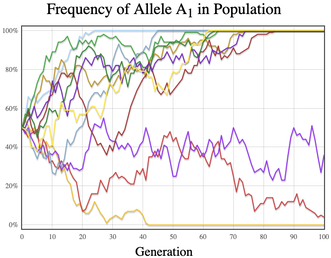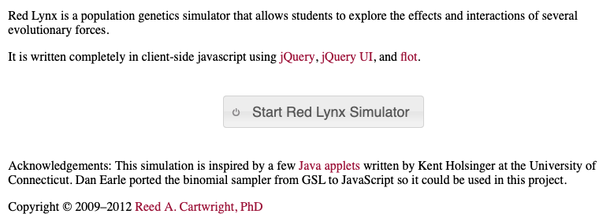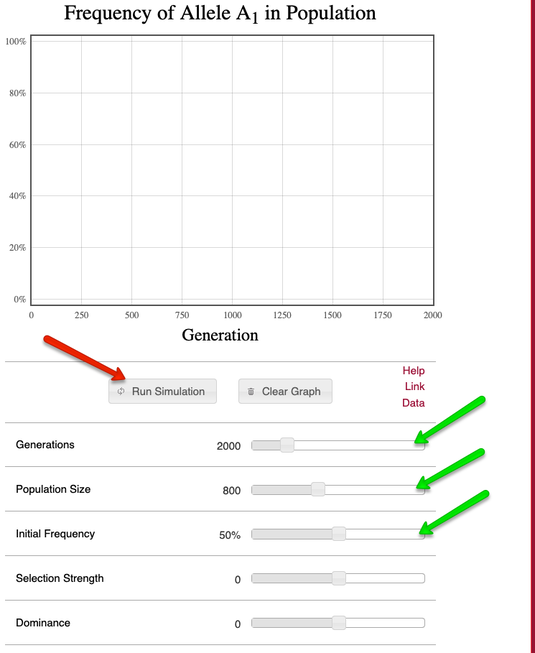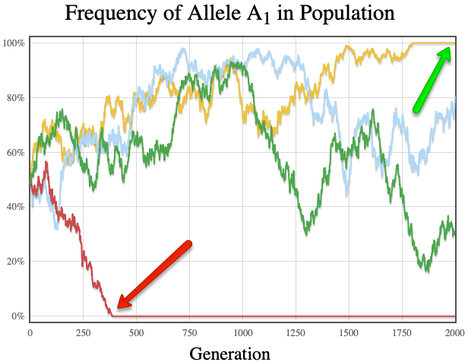| There might be thousands of dogs in your breed, but the ones that are bred and pass their genes to the next generation are the only ones that really count in terms of genetics. In most breeds, only 20-30% of the dogs produced are used for breeding. The rest go to pet homes, usually with a contract that stipulates that the dog cannot be bred or offspring cannot be registered. These dogs join the ranks of the spayed and neutered. This means that the number of dogs producing offspring in a breed is much less than the census number. This has significant consequences for the genetics of the breed. |
One of these is an online population simulator called Red Lynx. It's easy to use, and if you have access to the internet you can take it for a test drive.
Go the the Red Lynx website at https://cartwrig.ht/apps/redlynx/.
This will take you to the simulator and you should see the screen below.
Red Lynx simulates the "behavior" of a single allele, "A1", in populations with various properties. There are two alleles at every locus, so actually A1 has a pair (lets call it A2). But we only need to simulate one allele, because if the frequency of allele A1 in a population is going up, the frequency of A2 must go down. If we model the behavior of A1, we know that A2 will be responding as a mirror image. So, we will run our simulations using only a single allele at a locus.
On the simulation page, you will see a graph, and below that a series of parameters that you can change using some simple sliders. We are only going to play with the first three: number of generations, population size, and initial allele frequency (green arrows). You can change these either by using the slider or just type the number you want in the box. You can ignore the rest of the sliders on the page.
Okay, let's see what this does. Let's start with the default values when you first go to the page, which are 2000 generations, population size of 800, and initial frequency of A1 as 50% (so we know that the frequency of A2 will also be 50%). Click on "Run Simulation" (red arrow). A line will appear on the graph.
This line is the predicted behavior of the allele A1 in this population over time, assuming a 50/50 chance of inheriting the allele at each generation in a population under "ideal" conditions - no selection, no migration of A1 alleles in or out of the population, and no mutation. You can see that the initial frequency is 50%, and from there it change in frequency in the population with each generation.
Now, without clearing the graph, do a few more simulations. Each of these lines will be different because the role of chance in inheritance at each generation. If you do enough of these, you might see one of the lines go either all the way to 0% and flat-line (red arrow), or to 100% and stay there (green line). In the first case, all copies of the red allele have been lost from the population; for the green arrow, the alternative allele (A2) has been lost completely, leaving only A1, a situation we call "fixed" for that allele.
So what?
I hear you say "That's cool, but so what?".
Let's say the A1 allele was for something like the ability to smell a particular scent. If this isn't something you would be selecting for, this simulation suggests that there is a chance it could be lost from the population just by chance, a phenomenon called "genetic drift". Maybe this scent wasn't important to you, but if it was to the dog (e.g., a pheromone), it would have consequences that might affect some aspect of the physiology or behavior of the dog. Perhaps it is an allele that prevents fearfulness; losing it from the breed would definitely have consequences for the welfare of the dog. Or maybe it is an allele at a locus that is most beneficial when heterozygous - that is, the genotype A1A2 is more beneficial to the dog than either A1A1 or A2A2, something called "over-dominance". If one of the alleles is inadvertently lost from the population, all individuals will be homozygous for the other allele, and beneficial effects of heterozygosity will be unavailable.
Let's make the number of generations in the simulation 100 so it will be more relevant to dog breeding. Change the population size to 50, and leave the allele frequency at 50%. Use the button to clear the graph, and run some simulations.
You should find that the frequency of A1 goes to one extreme or the other (0% or 100%) in many of these simulations.
Now run some simulations with different population sizes, perhaps 100 and 25. How does this affect the graph?
This simulator makes it easy to explore the effect of population size on the behavior of alleles in the population that you might not be paying any attention to. Clearly, the genetic stability of a population is sensitive to the number of individuals.
Why does this matter to your breed?
How big is your breed? What fraction of the puppies produced are used for breeding? Remember, only reproducing animals count when we're considering genetics. What are the effects of breeding contracts or spay/neuter policies on the population genetics of your breed? How stable is it genetically to the chance loss of alleles by genetic drift?
These changes in allele frequency occur in all populations. If a population is divided into closed subpopulations, the same phenomenon will occur in each of them. This will cause them to drift apart genetically over time. Breeders can take advantage of the genetic differences in these subpopulations to use them as outcrosses that can restore alleles that have been lost in another subpopulation. You can simulate this using the slider for "migration". If breeders can work together to monitor the genetic status of these subpopulations in a breed, they can reduce the loss of genetic diversity, slow the increase in inbreeding, and benefit from the hybrid vigor produced by an outcross.
Is the population of your breed stable, or is it one of the many with registrations dropping off and fewer active breeders than there used to be? The simplest thing you can do to reduce the chance of losing important genetic diversity from your breed is to use more of the dogs produced in the breeding program. If the usual fraction is 20%, increase it to 40% or more. Don't send so many puppies off with contracts that prohibit breeding, or breed once before spaying or neutering. How much of a difference will it make? You can check it out using the Red Lynx simulator. Just remember that the simulator assumes a population with no selection, no migration, and no mutation (unless you stipulate conditions for these using the sliders). Certainly a purebred population will be under selection for the traits for type, but you can assume there is no selection for the "neutral" alleles that have no effect on type.
Check out what we offer
ICB's online courses
***************************************
Visit our Facebook Groups
ICB Institute of Canine Biology
...the latest canine news and research
ICB Breeding for the Future
...the science of animal breeding






